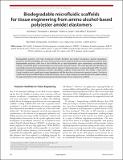Biodegradable microfluidic scaffolds for tissue engineering from amino alcohol-based poly(ester amide) elastomers
Author(s)
Wang, Jane; Bettinger, Christopher J.; Langer, Robert; Borenstein, Jeffrey T.
DownloadLanger_Biodegradable microfluidic.pdf (543.7Kb)
OPEN_ACCESS_POLICY
Open Access Policy
Creative Commons Attribution-Noncommercial-Share Alike
Terms of use
Metadata
Show full item recordAbstract
Biodegradable polymers with high mechanical strength, flexibility and optical transparency, optimal degradation properties and biocompatibility are critical to the success of tissue engineered devices and drug delivery systems. Most biodegradable polymers suffer from a short half life due to rapid degradation upon implantation, exceedingly high stiffness, and limited ability to functionalize the surface with chemical moieties. This work describes the fabrication of microfluidic networks from poly(ester amide), poly(1,3-diamino-2-hydroxypropane-co-polyol sebacate) (APS), a recently developed biodegradable elastomeric poly(ester amide). Microfluidic scaffolds constructed from APS exhibit a much lower Young’s Modulus and a significantly longer degradation half-life than those of previously reported systems. The device is fabricated using a modified replica-molding technique, which is rapid, inexpensive, reproducible, and scalable, making the approach ideal for both rapid prototyping and manufacturing of tissue engineering scaffolds.
Date issued
2010-10Department
Charles Stark Draper Laboratory; Harvard University--MIT Division of Health Sciences and Technology; Massachusetts Institute of Technology. Department of Biological Engineering; Massachusetts Institute of Technology. Department of Materials Science and Engineering; Massachusetts Institute of Technology. Program in Polymer Science and TechnologyJournal
Organogenesis
Publisher
Landes Bioscience
Citation
Wang, Jane, Christopher J. Bettinger, Robert S. Langer, and Jeffrey T. Borenstein 2010 Biodegradable Microfluidic Scaffolds for Tissue Engineering from Amino Alcohol-based Poly(ester Amide) Elastomers. Organogenesis 6(4): 212–216.
Version: Author's final manuscript
ISSN
1555-8592
1547-6278